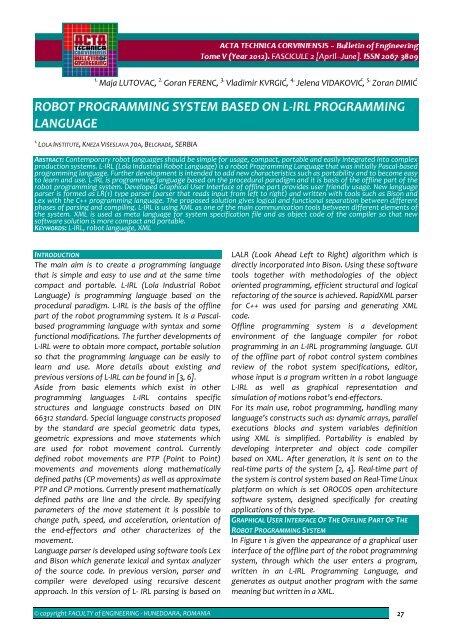Editorial & Advisory Board - Acta Technica Corviniensis
Editorial & Advisory Board - Acta Technica Corviniensis
Editorial & Advisory Board - Acta Technica Corviniensis
Create successful ePaper yourself
Turn your PDF publications into a flip-book with our unique Google optimized e-Paper software.
1.<br />
Maja LUTOVAC, 2. Goran FERENC, 3. Vladimir KVRGIĆ, 4. Jelena VIDAKOVIĆ, 5. Zoran DIMIĆ<br />
ROBOT PROGRAMMING SYSTEM BASED ON L‐IRL PROGRAMMING<br />
LANGUAGE<br />
1.<br />
LOLA INSTITUTE, KNEZA VIŠESLAVA 70A, BELGRADE, SERBIA<br />
ABSTRACT: Contemporary robot languages should be simple for usage, compact, portable and easily integrated into complex<br />
production systems. L‐IRL (Lola Industrial Robot Language) is a robot Programming Language that was initially Pascal‐based<br />
programming language. Further development is intended to add new characteristics such as portability and to become easy<br />
to learn and use. L‐IRL is programming language based on the procedural paradigm and it is basis of the offline part of the<br />
robot programming system. Developed Graphical User Interface of offline part provides user friendly usage. New language<br />
parser is formed as LR(1) type parser (parser that reads input from left to right) and written with tools such as Bison and<br />
Lex with the C++ programming language. The proposed solution gives logical and functional separation between different<br />
phases of parsing and compiling. L‐IRL is using XML as one of the main communication tools between different elements of<br />
the system. XML is used as meta language for system specification file and as object code of the compiler so that new<br />
software solution is more compact and portable.<br />
KEYWORDS: L‐IRL, robot language, XML<br />
INTRODUCTION<br />
The main aim is to create a programming language<br />
that is simple and easy to use and at the same time<br />
compact and portable. L‐IRL (Lola Industrial Robot<br />
Language) is programming language based on the<br />
procedural paradigm. L‐IRL is the basis of the offline<br />
part of the robot programming system. It is a Pascalbased<br />
programming language with syntax and some<br />
functional modifications. The further developments of<br />
L‐IRL were to obtain more compact, portable solution<br />
so that the programming language can be easily to<br />
learn and use. More details about existing and<br />
previous versions of L‐IRL can be found in [3, 6].<br />
Aside from basic elements which exist in other<br />
programming languages L‐IRL contains specific<br />
structures and language constructs based on DIN<br />
66312 standard. Special language constructs proposed<br />
by the standard are special geometric data types,<br />
geometric expressions and move statements which<br />
are used for robot movement control. Currently<br />
defined robot movements are PTP (Point to Point)<br />
movements and movements along mathematically<br />
defined paths (CP movements) as well as approximate<br />
PTP and CP motions. Currently present mathematically<br />
defined paths are line and the circle. By specifying<br />
parameters of the move statement it is possible to<br />
change path, speed, and acceleration, orientation of<br />
the end‐effectors and other characterizes of the<br />
movement.<br />
Language parser is developed using software tools Lex<br />
and Bison which generate lexical and syntax analyzer<br />
of the source code. In previous version, parser and<br />
compiler were developed using recursive descent<br />
approach. In this version of L‐ IRL parsing is based on<br />
LALR (Look Ahead Left to Right) algorithm which is<br />
directly incorporated into Bison. Using these software<br />
tools together with methodologies of the object<br />
oriented programming, efficient structural and logical<br />
refactoring of the source is achieved. RapidXML parser<br />
for C++ was used for parsing and generating XML<br />
code.<br />
Offline programming system is a development<br />
environment of the language compiler for robot<br />
programming in an L‐IRL programming language. GUI<br />
of the offline part of robot control system combines<br />
review of the robot system specifications, editor,<br />
whose input is a program written in a robot language<br />
L‐IRL as well as graphical representation and<br />
simulation of motions robot’s end‐effectors.<br />
For its main use, robot programming, handling many<br />
language’s constructs such as: dynamic arrays, parallel<br />
executions blocks and system variables definition<br />
using XML is simplified. Portability is enabled by<br />
developing interpreter and object code compiler<br />
based on XML. After generation, it is sent on to the<br />
real‐time parts of the system [2, 4]. Real‐time part of<br />
the system is control system based on Real‐Time Linux<br />
platform on which is set OROCOS open architecture<br />
software system, designed specifically for creating<br />
applications of this type.<br />
GRAPHICAL USER INTERFACE OF THE OFFLINE PART OF THE<br />
ROBOT PROGRAMMING SYSTEM<br />
In Figure 1 is given the appearance of a graphical user<br />
interface of the offline part of the robot programming<br />
system, through which the user enters a program,<br />
written in an L‐IRL Programming Language, and<br />
generates as output another program with the same<br />
meaning but written in a XML.<br />
© copyright FACULTY of ENGINEERING ‐ HUNEDOARA, ROMANIA 27

















